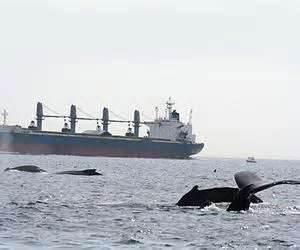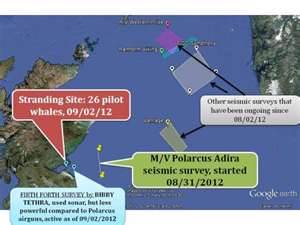When my neighbor cranks up his stereo, the bass makes my adjoining apartment walls hum. If the percussion ramps up, then my ears ring, too. But, I don’t mind, since I usually like music my neighbor plays. If I don’t like what I’m hearing, I’m quick to ask him to turn down the volume.
 I’m lucky. All I have to do is ask, and my home is quiet again.
I’m lucky. All I have to do is ask, and my home is quiet again.
Our ocean-dwelling neighbors don’t have that option. When our noise invades the watery living room of sea lions, dolphins, whales, and all the other marine life, they only have two choices: stay or go. They can’t knock on our doors—even when we know we’re being too loud.
We’ve been ramping up the volume for years. Noise in the oceans has doubled in each of the last four decades, according to a study conducted off Point Sur, California. He documented a 10 decibel rise in ambient ocean noise compared to U.S. Navy recordings taken on the West Coast in the 1960s. Shipping vessels are the biggest contributors, but sound spikes from Naval training exercises, airplanes, and other man-made sources also raise the noise levels under water.
Although many studies have documented the harmful effects of loud noise on marine mammals, that didn’t stop PG&E from seeking approval for underwater seismic testing near marine protected areas along the Central Coast. The survey could blast marine life with sound waves up to 190 decibels— louder noise than you’d hear at firework displays (100 dB), most rock concerts (110 dB), beside a chainsaw (120 dB), and after you’d rupture your eardrum (150 dB).
The utilities company wants to update maps of the Hosgri and Los Osos fault lines. The lines run under Estero Bay, near the shoreline of San Luis Obispo County, where the Diablo Canyon nuclear power plant nestles in the hills.
After last year’s Japanese earthquake and tsunami caused a reactor meltdown at the Fukushima Daiichi plant, the new maps could help evaluate safety strategies for the power plant, said PG&E director Mark Krausse, at the Coastal Commission hearing on Nov. 14.
The survey called for 18 air guns, towed on 30-foot underwater lines, to blast sound waves at the sea floor every 15-20 seconds, every hour, 24 hours a day, for 12 days. The ship would also drag underwater microphones to listen to sound waves bouncing back from below. That acoustical 3D map would improve on maps already available, said Krausse.
For marine life, which relies on sound for everything—finding food, mating, avoiding predators, and migrating—loud blasts of noise can cause problems ranging from interference with daily activities, to trauma, or even death.
In a study published last February, researchers at the New England Aquarium showed significantly lowered stress hormones in endangered Right whales when shipping traffic was shut down in the Bay of Fundy, after the events of 9/11.
Other studies, by the U.S. Navy, have shown cetaceans swim away to avoid sonar levels below 99 decibels. That sound level is less than the average 100-decibel boom from fireworks. Their research also found that acoustic sensitivity varied by species. Killer whales leave noisy areas before other cetaceans, even at lower decibel levels. 
Underwater sonar testing during military exercises has been linked to mass strandings of dolphins and whales around the world, from Madagascar to Cape Cod.
Before permits are approved for any activity that could affect marine mammals, the Coastal Commission requires an environmental impact assessment report. That report estimates the number of marine animals “taken”— meaning taken out of their natural habitat as a result of a project.
The PG&E plan estimated “takings” that included: 15 endangered blue whales, almost 100 gray whales, more than 1,000 sea lions, and 1,652 Bottlenose dolphins.
Although the big numbers are alarming, there is also danger in small numbers—such as the seven takings listed for Morro Bay Harbor porpoise— that don’t reflect the long-term hazards for marine life, according to the final environmental impact report from the California State Lands Commission.
 The Harbor porpoise only breeds among their Morro Bay population, and their core habitat is within the proposed PG&E testing area. These animals are considered the most sound-sensitive among marine mammals. Any noise disruption to their habitat would interrupt their daily feeding, breeding and calving season. Even if only seven of these marine mammals were affected, it could be too many for their isolated population, according to reports from the National Resources Defense Council.
The Harbor porpoise only breeds among their Morro Bay population, and their core habitat is within the proposed PG&E testing area. These animals are considered the most sound-sensitive among marine mammals. Any noise disruption to their habitat would interrupt their daily feeding, breeding and calving season. Even if only seven of these marine mammals were affected, it could be too many for their isolated population, according to reports from the National Resources Defense Council.
The estimates also didn’t include the negative impact on the hearing of fish, or the anticipated drop in fishery populations; which have both occurred in the aftermath of seismic surveys in other marine areas. Nor is there a tally of animals that never come back.
The PG& E seismic survey project was resoundingly rejected at a raucous Coastal Commission meeting on Dec. 5. More than 300 ocean and marine-life advocates crowded the meeting room in Santa Monica to speak against the project. There won’t be a survey starting this November.
I was heartened to see hundreds of people rally against this particular project. But, I still worry.
Even though this seismic test was stopped, we continue to create noise pollution. Without a corporate foe to fight, will we tune out our ocean-dwelling neighbors’ need for a quiet home life?







Comments are closed.